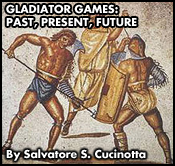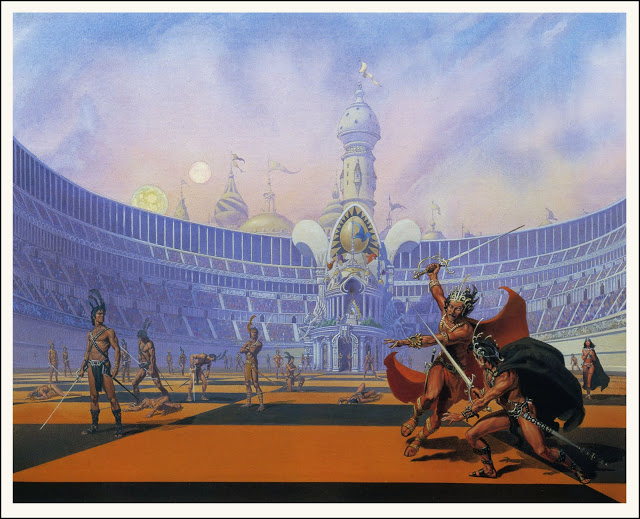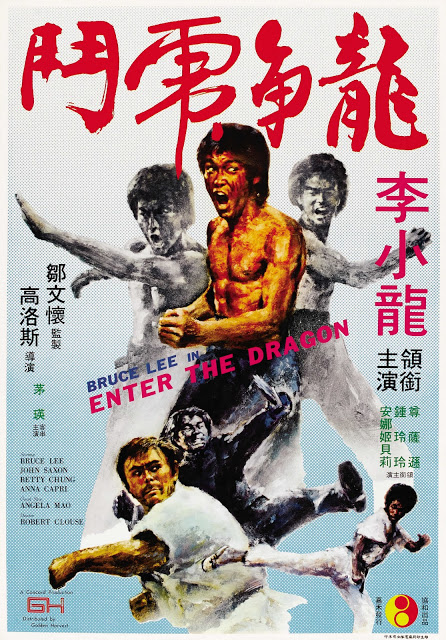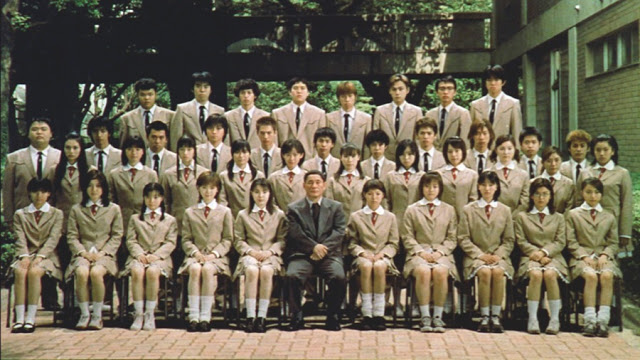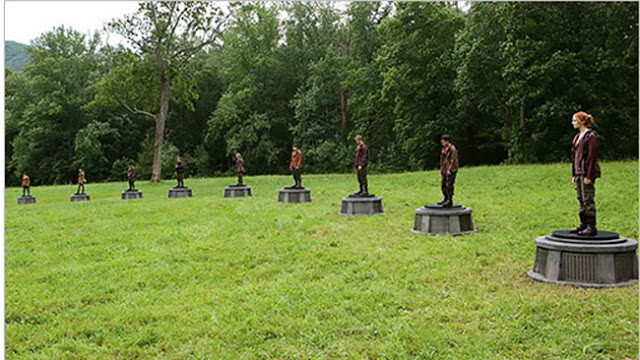Alright, after that massive history lesson, we can press onward into the realm of fiction proper and see how the games have been adapted to modern and futuristic settings.
It actually took quite a while for the games to be represented in fiction to a significant degree. Over time, the games saw themselves adapted to suit the needs of the viewing audience both in what they were and what they meant. This ranges from an initial misunderstanding, to shifts in the style of violence, to its very meaning.
The earliest ones fit a mold which I mentioned in the first part: the idea that the games themselves were caused by decadence rather than, as the Roman’s saw it, a treatment for it.
Science fiction stories were the ones to really run with this idea and find ways to exaggerate it in interesting ways.
Edgar Rice Burroughs, creator of Tarzan, incorporated the games into his Barsoom series, which the film John Carter is based on. Here, the decadence is caused by the alien beings of Barsoom (Mars) being unable to die in any way other than violence, and the entire world slowly dying. Immortality can get very boring, and they live in a brutal world.
Combine the two and bam! Instant excuse for death games.
In The Chessmen of Mars, we see one game in detail as the son of John Carter finds himself drawn into one and tries to rescue his love interest from the very same. It’s an extremely detailed game, but it boils down to a version of the 80s computer game Battle Chess done with real people and captures that could be contested vigorously by the ‘pieces’.
Star Trek the original series, used gladiator games on several occasions. “The Gamesters of Triskelion” is the one most worth talking about, as it provides a true sci-fi twist. Here, the titular game-masters were being so evolved, they were only brains. And they were extremely bored. Having vast powers to compensate for their lack of bodies, the kidnapped beings from across the galaxy (including Kirk, Uhura and Chekov) and had them compete in games and do other things. All of this was done not so they could just watch and gamble as ‘beings of pure intellect’. They cared little about the captives, but wanted something to stimulate them, and the implied vicarious enjoyment of something they could not take part in directly (physical activity) speaks to the deeper meanings Star Trek is often praised for.
Overall, it was far more Roman and roundly avoided the overarching theme I mentioned that most of these stories suffered from. The 70s brought in several films which changed pop culture’s understanding of the games and added new things to the core ideas already present.
1973 gave us a classic movie, which set the stage for martial arts to explode into western consciousness: Enter the Dragon. Though Way of the Dragon actually had a battle in the Coliseum (between Bruce Lee and Chuck Norris, which I recommend everyone see, it was Enter the Dragon which really brought it to mainstream consciousness.
This shifted the various Gladiator Games from fighting wild beasts or with weapons, to martial arts contests. It also adds that the idea that the people who volunteer for these games, to the death or not, do so for honor and glory. A very Roman thing to do, though the Honor aspect is more about satisfying honor by defeating a specific opponent rather than gaining it through the combat itself. The major characters in Enter the Dragon had more than that basic reason to join in the contest: Bruce Lee’s character is there for revenge and on a spy mission; John Saxons’ character is there for money; and Jim Kelly’s is there for respect.
These ideas and motivations are repeated in dozens of stories that followed in its footsteps, from movies like Bloodsport through to video games like Mortal Kombat. Enter the Dragon also puts in the idea that the fighting and winning the tournament are secondary to the actual plot – stopping the game runner from doing some evil deed (which may or may not be the game) usually takes precedent. It took the idea of Spartacus into the post-James Bond world. The Romans themselves would probably be pretty okay with the game, though not the film itself. The idea of rebellion from the lower ranks was horrifying to them.
Enter the Dragon also provided the idea that a person of independent wealth could run the games for his or her own purposes, an emperor unto themselves. This idea was picked up again in the newspaper comic Modesty Blaise, in an arc entitled “Those who are about to die.” In Enter the Dragon’s case, the host of the game was setting it up primarily as an audition for his criminal organization. He was driven to use martial artists due to a psychological antipathy for guns and a severe interest in the martial arts. In the Modesty Blaise story, the game runner has his desires come off more as a fetish (which isn’t exactly unexpected for a Modesty Blaise story). I’m sorry to say that most stories which use that excuse prefer to employ the idea of decadence as the underlying reason rather than other motives.
The next thing to be added to the genre came in the film Rollerball. This movie used the games as a part of a vehicle for modern social commentary (anti-corporate attitudes in this case). It was followed by Deathrace 2000 and The Running Man, which I think are much better films overall, but share overall similar messages with different core games to bring it up. Remakes of Deathrace 2000 and Rollerball exist. That’s all I can say about them and remain cordial.
All three original films share the same basic themes: a dystopian future (usually run by corporations or Corporate-Government-Religion hybrids) which use a violent blood sports (among other things) to distract the populace from more pressing concerns about life and to publically remove rebellious elements from their new society. The Rebellion aspects vary from film to film, but the cores remain to same. The latter two have a lot more going for it that Rollerball, though it got the ball “rolling” on the idea. It also helps that the latter two work in black comedy to make the commentary stand out more.
Exaggerated caricatures make up the competitors, show runners and even the commentators, each using the games to comment on the cultures of the time and hit on things which ring true to this day. There’s things like Euthanasia Day, which are just bloody hilarious, and remind me of the “Death Panel” scare.
None of the commentaries are subtle in these movies, and they wouldn’t really work if they were. I think the camp nature of these games enhances the overall of them and adds to the strength off the commentary. And boy, are these things campy. I mean, aside from Rollerball, one’s a Schwarzenegger movie, the other has David Carradine, Sylvester Stallone, and it’s directed by Roger Corman. Subtle withers and dies in the light of such a vast amount of camp.
These films also introduce the idea of the game-master (be it a show runner or government) in near direct or total control over the game. This is honestly a mixed blessing. I find that the idea of a big-brother government, or extremely voyeuristic individual, using the games as a grand distraction honestly has a hollow ring to it compared to the source. Sure, Rome had an emperor and strict laws, but they were not the source of the games. Otherwise, every other totalitarian regime would spawn such things. The only other culture to produce anything similar, the Azteks, did so as religious rights. Power does not breed death games in and of itself.
As to the games themselves, the Romans would be absolutely okay with them. The combination of their two favorite things (Gladiators and Chariot Races) in Deathrace 2000 in particular would be right up their alley. The commentary aspects and rebellion would, however, negate the enjoyment of the films themselves.
The next big film to influence the genre overall came in Fight Club. Now, honestly, it’s not so much a true gladiator film, but its influence filtered into that genre in various attempts to retell this basic story. Mostly, this comes in both the reason for any fight, the setup of it and the theme of reclaiming masculinity. Yeah, it really doesn’t fit if there’s a person running it, but that’s what happens when people try to ape popular works without understanding them. Remember this, it will be important later.
Fight Club did have the idea of the fight being a ‘reclamation of masculinity’ to fight off the decadence of society that has ‘neutered’ men. That is the distilled essence of gladiatorial combat as the Roman’s saw it. Though not a film about gladiators, it’s more gladiatorial than Russell Crowe’s Gladiator or even Spartacus. That it went on to spark similar ‘fight clubs’ in people’s back yards is something that requires its own separate analysis, but do keep in mind how death was handled within Fight Club before starting to crow about how close modern society is to those times.
These core sources (Enter the Dragon, Deathrace 2000, Fight Club, etc.) were the primary templates drawn from for TV show takes on gladiator plots, which generally amounted to mixing and matching these scenarios. And believe me, there’s been a lot of them. You can’t really have an action show (or even a police procedural these days) without bumping into it within the first or second season. The list includes, but is not limited to: Walker: Texas Ranger, Jackie Chan Adventures, Renegade, Martial Law, Witchblade, Birds of Prey, Dark Angel, Star Trek Voyager, Blood Ties, Being Human, Torchwood, Sanctuary, and CSI. Sometimes, rather than just throwing their characters into a classic plot as an homage, they try and spice it up: the combatants aren’t human; the combatants are all women; the combatants are all nonhuman women; etc.
My special commendation for a unique twist when handling this plot goes to Angel, which does this plot with various demons. It gives the combatants a carrot as well as a stick to work with, is run for gambling purposes from a relatively large underclass, but is unfortunately used in part as a ‘decadence is evil’ signpost. But the ending twist makes it stand out from all the other TV versions I’ve mentioned. As is common with this sort of thing, the heroes shut down the arena and free the captives. Battered and beaten, the heroes look on as the prisoners flee into the night joyously, only then realizing that they just unleashed almost a dozen extremely dangerous and powerful demons into Los Angeles, free to do whatever it is they want.
Oops.
And that’s just on TV. Comic books have had this plot frequently as well. DC even has a villainess (or did until the reboot) who specialized in death games to kill superheroes, where super villains bet on the various contests which ranged from standard gladiator matches to races to even a lethal form of chess. I can’t imagine that business model actually working due to the small pool on which it draws from, but as part of the narrative it was generally an excuse for fight scenes and resolving interpersonal conflicts between the cast members, so I can let it slide. In the last decade, there’s been a LOT of comics that have gladiator games as either a major plot or over-arching plot: Countdown: Arena, Youngblood: Bloodsport; Deathmatch; America’s Got Powers; Idolized; Terror Titans; Teen Titans: The Culling; and The Darkside Club Meta-arc appearing in Teen Titans, Birds of Prey and Infinity Inc..
Most of these are rather haphazard and not well thought out. Teen Titans: The Culling stands out as notoriously bad with a villain whose evil scheme is so utterly moronic that it’s hard not to think of him as a parody until the reader realizes the whole thing is being played straight.
There’s one more thing to talk about which is set to change the nature of the Games for years to come: the one two punch of Battle Royale and The Hunger Games.
Here, the game is turned from one on one contests to, well, Battle Royales, where the winner is the last one left alive. The event is spread over days and it involves children, as opposed to adults, to add to the horror and loss of life. These two works are primarily tragedies, with the deaths seen as wasteful and horrific in all aspects.
This is more prominent in Battle Royale but it’s still present in The Hunger Games to a degree. They are also heavily symbolic, harkening to the divide between adults and kids in Japan for the former and the second Iraq war in the latter.
In truth, neither of these are gladiator games.
They are closer to the executions held within the amphitheater, and two instances in particular. One of them involved Caligula, so prepare for madness. During one games he held, he ran out of prisoners to throw to wild animals. But Caligula had a wonderful solution to keep the games going that morning. He had his men grab a section of the lower class audience and throw them in as substitution players, as it were. You’d think something like that would be mentioned more regularly as ‘reasons why everyone hated Caligula,’ but he killed so many people under far less pretenses, that it just gets lumped in with all the rest.
The second example can be found in a rather standard execution game from the mornings of Rome. The poet Seneca once caught a glimpse of this game (as the learned and upper classes didn’t really watch the games until evening, to avoid the garishness of the pregame shows) and was rather appalled by it. The game was the Battle Royale or Hunger Games scenario, condensed into a single hour and not involving teenagers: a group of prisoners were forced to fight each other, unprotected, until they were all dead.
“It’s pure, unadulterated murder. There’s no helmets, no shield to repel the blade. Why bother with skill? All that just delays death. As soon as a man kills, they shout for him to kill another or be killed.”
One might think that these games wouldn’t really appeal to the Romans, but, well, they wouldn’t but for the wrong reasons.
Surprisingly, they would not object to the age of the combatants that much. It wasn’t until a law was passed later on that an age limit was put in for women at the very least. Surviving records from the town of Lanaraium (modern day Larino) from the earliest years of the Roman Republic tell of a law stating that that no woman under the age of twenty could compete. This implies that some young women had signed up to be or otherwise became gladiators. And I know of no law like this that existed for men. Tallied together with marriage ages in Rome, it implies that teens as young as 15 might have competed. If there’s a thesis for this series of articles, it has got to be “Romans were jerks”. Because of its length, the lack of training, and the point not being to show assertions of dominance nor accepting defeat honorably, the Romans wouldn’t like Battle Royale or The Hunger Games.
Because of their size and complexity, TV hasn’t really had a chance to really adapt one of these yet as far as I’m aware. The closest I’ve seen was found in an episode of Supernatural which commits the one unforgivable sin of this sort of game, one that is repeated in many of the examples I mentioned: that the winner of such a game is the deadliest of the bunch rather than just a lucky survivor. I don’t know where the idea comes from, but it always struck me as moronic. The CW even looked into turning Battle Royale into a TV series, but nixed the idea thanks to the upswing in school shootings. Good taste prevails.
There is one other that follows in the footsteps of Battle Royale and The Hunger Games. A comic book called Avengers Arena, the most divisive Marvel series to be released in years. We’ll talk about that in the final article in this series.




































































































